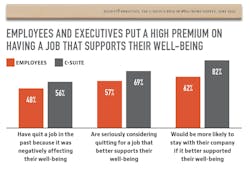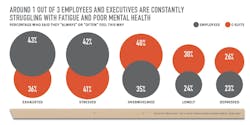You Need To Talk About It: Mental Health In Construction
Chris Bolio had a stroke. Days after completing a triathlon, carrying granite slabs on the jobsite, and finishing up a custom home, the Houston-based contractor lost control of his left hand and began walking into walls.
Over time, the fit, healthy 28-year-old would learn to put his own socks on again, walk with a cane, and dress himself with his working right arm. But he was also the one-man leadership team behind Bolio Custom Homes.
“When I got home, I’m thrust back into real life. I have projects to finish, which I can’t, and a home life to navigate,” recalls Bolio.
Day by day, Bolio’s condition improved, but not without unforeseen challenges. In a quiet room, he shared with his neurologist that physically, he was doing better. Mentally, not so much. Recalling the moment, he uses the word “courage” to describe what it took to share his feelings of overwhelm.
I never thought that I would be that person, but the reality is that we’re all that person given the right circumstances.
What followed was a commitment to therapy, 10 years of antidepressants, and a whole lot of business success. Bolio, now owner and regional partner for Alair Homes Houston, would go on to successfully run his construction company for 18 years—and counting.
“Had I not accepted that I was in a severe depression, had it not been okay for me to get help, had I not taken the steps and given myself that permission to need help, I don’t know that I would be sitting here today,” says Bolio. “I never thought that I would be that person, but the reality is that we’re all that person given the right circumstances.”
Bolio is unique in the way he openly shares his story of crisis and vulnerability. Most in the construction industry are not so forthcoming. In fact, poor mental health is the industry’s leading cause of death, with widespread unwillingness to discuss the issue adding to the problem. And while some in the industry look to change that culture, data shows not enough has been done.
A SILENT KILLER
In 2016, The Center for Disease Control and Prevention (CDC) published its first report on suicide rates by occupation. The top occupational group? Excavation and construction. The second industry most affected by male suicide rates? Construction.
Men in construction die by suicide at a rate nearly four times the general population’s national average and nearly double the total suicide rate of men overall. A jobsite presents daily physical risks, yet the most common cause of death—at a rate five times higher than all other work-related fatalities—is suicide. It’s the industry’s biggest—and most silent—killer.
“There’s a mental health issue in America, and nobody wants to speak about it,” says Casey Baldovin, owner of Baldovin Construction in Peoria, Ill. “And then you take that, and you put it into the construction trades, and it’s just tenfold.”
These sobering statistics beg one question: Why?
[We’re expected to be] a guide for our clients, a money manager, a great contractor, great project manager, great therapist, great listener, great communicator, great boss, great mentor—all those things all the time.
AN INDUSTRY AT RISK
Construction is rife with risks to mental health. It’s male-dominated, high stress, and carries high levels of addiction, business instability, and intense physical work.
Another data set where construction exceeds expectations? Addiction and dependency. And that comes as no surprise. In an industry where you work with your body, there’s a higher chance for injury and subsequent pain management (See sidebar “Addiction’s Role.")
It’s also a highly competitive and stressful industry with boom and bust business cycles and an org chart that often features one person running the company, managing a team, and acting as the face of the business.
“There’s such an industry expectation to know what you’re doing all the time and be the expert,” says Bolio. “[We’re expected to be] a guide for our clients, a money manager, a great contractor, great project manager, great therapist, great listener, great communicator, great boss, great mentor—all those things all the time.”
THE EFFECT OF STIGMAS
The construction industry is 89% male, according to BLS, and for many men, discussing mental health remains a cultural taboo.
A striking generational split adds to the complexity of the issue. While a younger workforce is needed to alleviate labor shortages, the older generation, who are often tasked with guiding and teaching the new labor, rarely discuss mental health.
Guys in construction… We’re supposed to have it all figured out. We’re supposed to be tough and be able to handle anything that’s thrown at us, which is impossible for most.
“I’m a second-generation carpenter, and growing up, my dad was the epitome of a badass dude, big guy,” says Baldovin. “We grew up not talking about emotions, so you don’t really have the tools.”
Maintaining that “tough guy” image also brings its own kind of pressure. “Guys in construction… We’re supposed to have it all figured out. We’re supposed to be tough and be able to handle anything that’s thrown at us, which is impossible for most,” says Colt Byrom, a fourth-generation custom builder and president of Byrom Building in Birmingham, Ala.
To Byrom, it wasn’t okay to not have everything “figured out” because other business owners seemingly did. They were fathers, husbands, builders, and, in his eyes, they held it all together seamlessly. But the stress became too hard to handle on his own.
“Trying to uphold that perfect outward appearance comes at a cost, [there are] lies you tell yourself or other people. That was a big struggle of mine to come to realize,” says Byrom.
In 2019, after much convincing and self-reflection, Byrom found a Christian counselor who helped him address his feelings of stress and overwhelm.
Not long afterward, following a local Alabama Home Builders Association meeting, Byrom was chatting with five other successful contractors when, to his own surprise, he shared his recent experience with counseling. To his even greater surprise, every other business owner present revealed that they had made a similar choice to seek counseling at some point in their lives.
“I thought that I was going to see this counselor to talk through issues, and no one else does this,” recalls Byrom. “And here, we have a conversation, and I find out that six out of the six guys all had, at some point, done that.”
Today, Byrom continues monthly sessions with his counselor, which he says have made him a better leader, husband, and father. In the field, project managers and trades people suffer from their own stereotypes.
“There’s a stigma against tradespeople,” says Baldovin. “You’re trying to… get people to feel positive about themselves when America has basically told everybody if you don’t have a degree, you’re worthless. And if you’re in the trades, you’re double worthless.”
For Guy Moffitt, project manager at Amsted Design-Build, clients demand the most of their contractors, and trust them the least, compounding stress.
“Everybody wants updates of everything you’re doing every day, especially clients. And everybody is watching. Neighbors chirp at you. You wake up at midnight to 1 a.m. worrying,” says Moffitt.
There’s a stigma against tradespeople,” says Baldovin. “You’re trying to… get people to feel positive about themselves when America has basically told everybody if you don’t have a degree, you’re worthless. And if you’re in the trades, you’re double worthless.
IT STARTS WITH THE LEADER
Ask any remodeler for their top business challenge over the past 10 years, and the answer you’ll likely hear will be “labor.”
In response to a chronic shortage of tradespeople, many company leaders have upped their culture in an effort to recruit and retain team members. Part of that means meeting employees’ needs for emotional, social, financial, career, and community well-being.
It’s a way to combat burnout, which can be intense in an industry like construction. A 2018 Gallup report found the five main causes of burnout stem from the job and managers, not from the individual.
“Overall well-being has been perceived as an individual pursuit,” says Laura Putnam, consultant and author of Workplace Wellness that Works. “And it ignores all of the environmental and cultural factors that play into the extent to which an individual can pursue their well-being.”
Data shows that one of the most impactful ways a business leader can create a culture that addresses mental health and well-being is by setting an example.
“When we get leaders telling their authentic story of anxiety, depression, trauma, addiction, even being a caregiver, or bereaved, all of those stories matter,” says Clinical Psychologist Dr. Sally Spencer-Thomas. “People say, ‘Well, if you went through all of that, and are as successful as you are today, then I can get through that and have a great life.’”
Spencer-Thomas, who conducts trainings and consultations on suicide prevention, works with business leaders to connect mental well-being with the mission of their company. She also encourages leaders to share personal stories.
To bring home the statistics, she then conducts confidential polling, asking the team if they have experienced, or know someone who has experienced, anxiety, depression, or feelings of overwhelm.
“And I say, ‘Look, this is not some other random group. This is this community. And you might not have known this about each other before we started, but it’s real,’” she says.
Steve Barkhouse runs Amsted Design-Build, a 58-person remodeling company in Ottawa, Canada. During the pandemic, an employee newsletter helped keep the team’s spirits up. Barkhouse shared photos of his long hair and humorous notes in order to maintain a lighthearted approach during a fearful time.
But he also used the newsletter to reveal his own feelings about celebrations that were postponed, aging parents he couldn’t visit, and funerals he missed. Unbeknownst to him at the time, his willingness to share was a culture-changer.
“In an effort to lead by example, I showed some vulnerability to my team, and the outpouring of love and support was overwhelming,” recalls Barkhouse.
When the company’s leader opened up, the employees felt they could too.
“If he needs help, I’m there. He’s a leader, and if he thinks it’s good, I’m in,” recalls Moffitt who, after being asked by Barkhouse, shared his highly personal experience with antidepressants with the greater team.
In an effort to address the topic of mental health in his own company, Barkhouse partnered with a Canadian research center and a corporate training firm for a full mental health workshop day, including a video where he, and other employees, dove deeper into their experiences during COVID, their work, and personal stories.
“I learned a ton from this thing,” says Barkhouse. “I am your stereotypical 50-something carpenter that’s like, ‘Mental health? I’m not gonna talk to anybody about that.’ I think [the team] probably came because if Barkhouse is going, it’s not going to be uncomfortable.”
A 2018 study conducted by ADP Research Institute backs this up. The research, which spanned 19 countries and more than 19,000 respondents, found that being part of a team with trust in leadership is the most important influence on employee engagement. The study also reported that 84% of employees are not fully engaged, and that engagement is the single best predictor of improved work performance and productivity.
BECOMING BETTER
To address the labor shortage, it’s imperative the industry take care of its existing workforce. To address the mental health crisis, it’s imperative the industry start talking about it.
“There shouldn’t be a stigma with wanting to improve yourself. Whether you’re at the top of your game, or at the bottom of a pit is a bit irrelevant,” says Bolio. “Improving is always a good thing. Improving is always positive. There’s always room to get better, to become a better leader or a better father or a better mother or a better husband or wife or a significant other.”
Below is a condensed list for quick resources and organizations focused on mental health and mental health in construction.
Visit proremodeler.com/mental-health for an extended list.
Suicide and Crisis Lifeline: Call or Text 988
Online Lifeline Crisis Chat: 988lifeline.org/chat
Occupational Safety & Health Administration: osha.gov/preventingsuicides
Safe Build Alliance: safebuildalliance.com/resources/mental-health-suicide-prevention
Construction Industry Alliance for Suicide Prevention: preventconstructionsuicide.com
Suicide Prevention Resource Center: sprc.org
The National Association of Home Builders: nahb.org/mentalhealth






